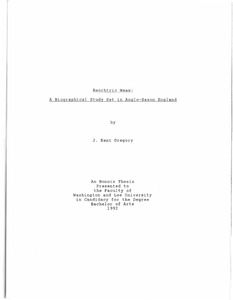| dc.rights.license | In Copyright | en_US |
| dc.creator | Gregory, J. Kent | |
| dc.date.accessioned | 2023-10-20T18:01:24Z | |
| dc.date.available | 2023-10-20T18:01:24Z | |
| dc.date.created | 1992 | |
| dc.identifier | WLURG038_Gregory_thesis_1992 | |
| dc.identifier.uri | https://dspace.wlu.edu/handle/11021/36516 | |
| dc.description.abstract | Having completed my research, a portrait of Beorhtric finally emerged in which he appeared as a powerful and wealthy thegn descended from a family tracing its descent to the Wessex royal line. He and his family appear to have been something along the lines of border lords at the Celtic frontier, to whom several lesser thegns throughout the West Country attached themselves. His family lived through the final 130 years of the Anglo-Saxon state, a period in which land became central to a Saxon's status and in which thegns rose in power to challenge the rule of their king. Beorhtric and his family survived these turbulent years, keeping their lands and status intact -- sometimes by allying themselves with enemies of the Wessex state. Beorhtric employed this tactic at the time of the Norman conquest by refusing to send aid to the English King Harold and by serving on the royal staff of William. This ploy to save his lands and status initially seemed to have worked, but Beorhtric lost everything by taking part in a doomed revolt against William and his grasping and treacherous agents. William stripped Beorhtric of his lands and threw him into jail. William placed so much emphasis on the strategic value of Beorhtric's former lands that he redistributed them only to his trusted friends and relatives -- hence the legend told by the Continuator to account for Beorhtric's loss. In the following chapters I will present the information and evidence that led me to my conclusions. Chapter I primarily deals with an introduction to the legends and what truth may be gleaned from them. Chapter II focuses on Beorhtric's status and position in Anglo-Saxon society in terms of his land holdings, taking into account their size, wealth, history, and other significant factors. Chapter III describes Beorhtric and his family in terms of AngloSaxon institutions, namely the posse comitatus and witan. Chapter IV takes into consideration the discussions of the previous chapters and sets Beorhtric and his family in the context of AngloSaxon history. Finally, I sum up my analysis and conclusions about Beorhtric in Chapter V. [From Preface] | en_US |
| dc.format.extent | 157 pages | en_US |
| dc.language.iso | en_US | en_US |
| dc.rights | This material is made available for use in research, teaching, and private study, pursuant to U.S. Copyright law. The user assumes full responsibility for any use of the materials, including but not limited to, infringement of copyright and publication rights of reproduced materials. Any materials used should be fully credited with the source. | en_US |
| dc.rights.uri | http://rightsstatements.org/vocab/InC/1.0/ | en_US |
| dc.title | Beorhtric Meaw: A Biographical Study Set in Anglo-Saxon England | en_US |
| dc.type | Text | en_US |
| dcterms.isPartOf | WLURG038 - Student Papers | en_US |
| dc.rights.holder | Gregory, J. Kent | en_US |
| dc.subject.fast | Civilization, Anglo-Saxon -- Historiography | en_US |
| dc.subject.fast | Domesday book | en_US |
